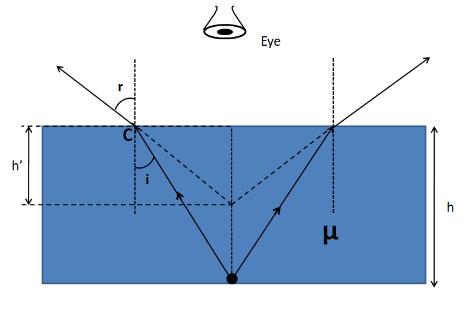
A swimming pool appears shallower than its actual depth due to
(A) Reflection
(B) Dispersion
(C) Refraction
(D) Scattering
Answer
555.9k+ views
Hint: To answer this question, we need to trace the path of the light rays as they travel from the swimming pool into the air. We have to remember that the eyes perceive the light rays entering to be travelling straight.
Complete step by step solution:
Let us consider a swimming pool of depth $h$ as shown in the figure below.

Consider that a human eye is observing a point situated at the bottom of the tank, adjusted for near normal viewing. We can see the rays originating from that point. Now, at point C, the light ray changes its leaves to the water medium, which is optically denser, and enters the air medium, which is optically rarer. We know that when the light travels from an optically denser to the rarer medium, it bends away from the normal, as shown in the above figure. The eye receives these bent rays. But it does not perceive the refraction which has taken place. The eye only perceives the light ray to be a straight ray which is originating from a point situated a little above from the original point. The perceived point can be obtained by joining the bent light rays. The same is the case with all the points situated at the bottom. Thus, the swimming pool appears to be shallower than its actual depth. Therefore, the phenomenon of refraction is the reason for this apparent depth.
Hence, the correct answer is option A.
Note:
We have taken the position of the eye to be near to the normal to the surface of the pool. But that does not mean that this effect does not take place for the other position. In fact this effect is independent of the position of the eye, whether it is normally viewing, or obliquely viewing.
Complete step by step solution:
Let us consider a swimming pool of depth $h$ as shown in the figure below.

Consider that a human eye is observing a point situated at the bottom of the tank, adjusted for near normal viewing. We can see the rays originating from that point. Now, at point C, the light ray changes its leaves to the water medium, which is optically denser, and enters the air medium, which is optically rarer. We know that when the light travels from an optically denser to the rarer medium, it bends away from the normal, as shown in the above figure. The eye receives these bent rays. But it does not perceive the refraction which has taken place. The eye only perceives the light ray to be a straight ray which is originating from a point situated a little above from the original point. The perceived point can be obtained by joining the bent light rays. The same is the case with all the points situated at the bottom. Thus, the swimming pool appears to be shallower than its actual depth. Therefore, the phenomenon of refraction is the reason for this apparent depth.
Hence, the correct answer is option A.
Note:
We have taken the position of the eye to be near to the normal to the surface of the pool. But that does not mean that this effect does not take place for the other position. In fact this effect is independent of the position of the eye, whether it is normally viewing, or obliquely viewing.
Recently Updated Pages
Master Class 12 Business Studies: Engaging Questions & Answers for Success

Master Class 12 Economics: Engaging Questions & Answers for Success

Master Class 12 English: Engaging Questions & Answers for Success

Master Class 12 Maths: Engaging Questions & Answers for Success

Master Class 12 Social Science: Engaging Questions & Answers for Success

Master Class 12 Chemistry: Engaging Questions & Answers for Success

Trending doubts
What are the major means of transport Explain each class 12 social science CBSE

Which are the Top 10 Largest Countries of the World?

Draw a labelled sketch of the human eye class 12 physics CBSE

How much time does it take to bleed after eating p class 12 biology CBSE

Explain sex determination in humans with line diag class 12 biology CBSE

Differentiate between homogeneous and heterogeneous class 12 chemistry CBSE




